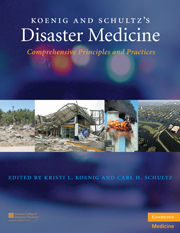Book contents
- Frontmatter
- Contents
- List of Contributors
- Contributor Biographies
- Foreword
- Preface
- Acknowledgments
- PART I CONCEPTUAL FRAMEWORK AND STRATEGIC OVERVIEW
- PART II OPERATIONAL ISSUES
- PART III CLINICAL MANAGEMENT
- SECTION A CBRNE AND HAZMAT
- SECTION B ENVIRONMENTAL EVENTS
- 32 Floods
- 33 Cyclones/Hurricanes/Typhoons
- 34 Tornadoes
- 35 Earthquakes
- 36 Tsunamis
- 37 Winter Storms
- 38 Extreme Heat Events
- 39 Volcanoes
- Index
- Plate section
- References
37 - Winter Storms
from SECTION B - ENVIRONMENTAL EVENTS
Published online by Cambridge University Press: 05 August 2011
- Frontmatter
- Contents
- List of Contributors
- Contributor Biographies
- Foreword
- Preface
- Acknowledgments
- PART I CONCEPTUAL FRAMEWORK AND STRATEGIC OVERVIEW
- PART II OPERATIONAL ISSUES
- PART III CLINICAL MANAGEMENT
- SECTION A CBRNE AND HAZMAT
- SECTION B ENVIRONMENTAL EVENTS
- 32 Floods
- 33 Cyclones/Hurricanes/Typhoons
- 34 Tornadoes
- 35 Earthquakes
- 36 Tsunamis
- 37 Winter Storms
- 38 Extreme Heat Events
- 39 Volcanoes
- Index
- Plate section
- References
Summary
OVERVIEW
Severe winter storms can be life-changing events that isolate and disrupt families; shut down schools, businesses, and government; prevent air, ground, and water transportation; and destroy large components of agricultural and service industries. Public safety can be threatened when roads are impassable, power grids are down, and telecommunications are inoperable.
Humans can exist in extremely cold environments, but their physiology remains geared mostly for the tropics from which the species originated. Adaptation to cold is most importantly behavioral. Heat loss is slowed or prevented by avoiding contact with cold surfaces and ingestion of cold substances, sheltering from wind and precipitation, wearing of protective clothing, and physically moving to a warmer location. Peripheral vasoconstriction and shivering only modestly and temporarily protect humans exposed to significantly cold temperatures. The consequences of many winter storms make it difficult or impossible for unprepared or unassisted humans to achieve the behavioral modifications necessary to mitigate the direct effects of cold or to obtain the resources needed to maintain health.
This chapter discusses the problems winter storms pose, how they fit into the continuum from minor annoyance to major disaster, and what can be done to prepare for future events that threaten the welfare of those in their paths. The disaster life cycle – mitigation, preparedness, response, and recovery – used here includes a continuous loop of planning and preparedness; warning, if any; the event itself; immediate response, which is almost always local; rapid assessment to identify needed resources; definitive response with ongoing surveillance and repeated assessments; recovery to baseline; and system improvements to increase preparedness for the next event.
Keywords
- Type
- Chapter
- Information
- Koenig and Schultz's Disaster MedicineComprehensive Principles and Practices, pp. 586 - 608Publisher: Cambridge University PressPrint publication year: 2009



